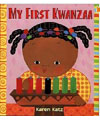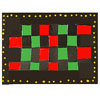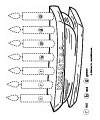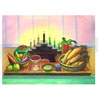Kwanzaa Celebration and Activities
Kwanzaa Activities
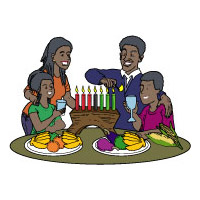
Objectives
Children will listen to a story.
Children will learn about Kwanzaa.
Materials
- Book: My First Kwanzaa Book by Angela Shelf Medeari
- Book: My First Kwanzaa by Karen Katz
Directions:
To introduce children to the Kwanzaa holiday, read a book such as Seven Days of Kwanzaa by Angela Shelf Medearis or My First Kwanzaa by Karen Katz. Explain to children that Dr. Maulana Karenga created Kwanzaa in 1966 because he wanted African-Americans to have a special time in which they could celebrate their heritage, or past. The word “kwanzaa” means “first” and symbolizes the first fruits of the harvest. People celebrate through singing, speaking, and dancing. It is built on seven principles or ideas called “Nguzo Saba.”
- umoja (oo-MO-jah) – unity (stresses importance of togetherness for the family and the community)
- kujichagulia (koo-gee-cha-goo-LEE-yah) – self-determination (reminds us that we need to be responsible and speak for ourselves)
- ujima (oo-GEE-mah) – collective work and responsibility (reminds us that we are a part of the community, society, and world)
- ujamaa (oo-JAH-mah) – cooperative economics (encourages us to work together to meet common needs)
- nia – purpose (encourages us to help others)
- kuumba (koo-OOM-bah) – creativity (encourages us to be creative)
- imani (ee-MAH-nee) – faith (encourages us to believe in parents, teachers, and leaders)
Kwanzaa lasts seven days, from December 26 to January 1. Each of the seven days of the celebration is dedicated to one of the seven principles. A candle is lit each day on a special candlestick called the “kimara” to represent these principles. The kimara is placed on a “mkeka,” a traditional straw mat, and one ear of corn is also placed on the mat for each child in the family. A fruit basket, called a “mazao” is also displayed, along with a special “unity" cup,” out of which everyone drinks. Families decorate their homes with traditional African crafts. The colors red, green, and black are used. Gifts, known as “zawadi,” are given on the last day of Kwanzaa.
Customary Greeting
Each morning, beginning on December 26, greet children with the following Swahili customary greeting used to greet friends and family “Habari gani,” meaning “What is the news?” To respond, children should answer with the principle of the day. (Umoja, for example, is the response given on December 26th.) Afterwards, have a discussion with children about the meaning of the principle.
Crafts
Zawadi
Tell children that in Africa many things are made by hand. To celebrate this African custom, gifts, or zawadi, are often exchanged on Kwanzaa. Let children make the beaded necklace below and give it to a friend or family member.
Beaded Necklace
Measure out a length of fishing line or string. Make a double knot at one end. String black, red and green (traditional Kwanzaa colors) beads onto the fishing line or string. If desired, have children create a pattern. Encourage children to tie the necklace securely around a friend’s neck. Let them make and exchange many strings of beads with friends.
Swahili Word Cards
Use African colors (red, yellow, black) to write these Swahili words on index cards. Present a new word to children each day. Encourage children to use the new word and previously learned words throughout the day: asante (ah-sahn'-tay): thank you; fundi (fuhn'-dee): teacher; habari (hah-bah'-ree): How are you?; jambo (jahm'-bo): hello; karamu (kah-rah'-moo): a thanksgiving harvest feast, held on the last day of Kwanzaa; kwa heri (kwa-heh'-ree): goodbye; matunda (mah-toon'-dah): fruit; tafadali (tah-fah-dah'-lee): please; wototo (wo-to'-to): children.
Additional Resources
For our Newsletter subscribers:
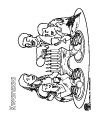
Kwanzaa
Coloring Page

Snack

Fried Bananas
Have children peel some bananas. Cut bananas into half-inch slices with a plastic knife. Place banana slices on a paper plate and sprinkle a little lemon juice, brown sugar, and cinnamon onto the slices. Melt butter in a frying pan over a medium heat. Place a layer of slices in the frying pan. Fry both sides of the slices until golden. Drain on paper towels and serve.





